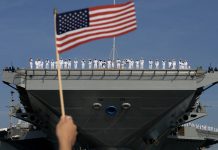The United States currently houses the most sought after and probably the most potent fighter jets in the world, the Lockheed Martin F-35 stealth jets.
Russia, China or The US: Which Country’s Air Force Operates The World’s Fastest Fighter Jets?
While the fighters have been a huge global success with Israel, Britain and few others already possessing the fifth-generation fighters in their ranks along with the US Air Force, the trillion-dollar F-35 fighter jet program has been marred by its fair share of issues.
Conceived in the 1990s, the Joint Strike Fighter (JSF) program was considered the most ambitious fighter development program in the history of the US Defence Department. The weapons program, till date, is the most expensive program in the world costing taxpayers over $1 trillion over its 60-year lifespan.
Under the program, which is the state military’s most enhanced international partnership, the fifth-generation fighter intended to replace a wide range of existing fighter, strike, and ground-attack aircraft for the United States, the United Kingdom, Italy, Canada, Australia, Turkey, the Netherlands, Denmark and Norway.
The JSF program would involve one company overseeing design and production of three different variants of the fighters which would be operated by the US Air Force, Navy and Marine Corps along with its US allies offsetting the development costs.
While the fighters were touted to reach the stars and prove to have immense superiority of other fifth-generation contemporaries, its problem began in 2014, just weeks before the F-35 was to make its international debut at the Farnborough Air Show in Britain.
While one of the pilots got on board the F-35 for a routine morning training mission, he heard a loud bang, with the fighter flashing its warning indicator to signal “fire” and other alerts suggesting that plane systems were shutting down.
Soon after, the pilot escaped the cockpit with the aircraft engulfed in thick plumes of black smoke.
Retired US Air Force General Christopher Bogdan, who was the Program Executive Officer of the F-35 Program at that time said – “If that engine problem would have occurred 30 seconds, 60 seconds, two minutes later, that airplane would have been airborne. Heaven knows what could have happened then.”
An investigation was underway soon after the incident to reveal the source of the problem. According to the New York Times – “An investigation of the incident determined that a fan blade in the jet’s engine had overheated from friction and cracked, throwing off fragments of metal that punched through the fuselage, severed hydraulic and fuel lines and ignited a spray of jet fuel.”
Despite a decade of delays and spiralling cost overruns, the event forced the Pentagon and developers Lockheed Martin to scrap the plans for the jets to be showcased at the air show.
However, post the incident Lockheed Martin was able to successfully rectify the problems and deliver planes to US forces and other nations, while also managing to reduce the unit per cost of the aircraft.
Upon the demands of the US Defence Department to reduce the high costs of the fighters, the price per aircraft went down from $82.4 million for lot 12, to $79.2 million for lot 13, to $77.9 million for lot 14, lesser than the desired reduction in cost.

However, the fighters continued to face other major complications which put the pilot’s life in jeopardy as well as a danger to the combat missions. According to Defence News, the jet were plagued with 13 severe technical deficiencies during its operational testing which included spikes in cabin pressure, some rare instances of structural damage at supersonic speeds and unpredictability while conducting extreme manoeuvres.
Moreover, the high cost of operating the fighters along with a shortage of spare parts and technical challenges the jet’s crucial software codes continued to haunt developers and the defence department.
Recently, during a mission known as Allied Sky, the F-35s of the Royal Netherlands Air Force were tasked to escort one of the B-52 bombers, however, the mission was abandoned soon after it was found out that the F-35a Lightning II fighters could not operate in turbulent weather.
Later, a statement issued by the Dutch Ministry of Defence said – “Damaged pipes have been found on F-35A fighters. These are pipes from the On-Board Inert Gas Generation System (OBIGGS) in a fuel tank. All countries with F-35As were advised to avoid flights near storm cells and to protect the aircraft on the ground by a shelter or lightning rod.”
According to a serving Indian Air Force Official, the incident goes against the basic functionalities of the modern aircraft and said – “F-35s are considered all-weather jets but an incident like that proves that the most advanced fighters in the world can have such basic problems. You may have as many bells and vessels on a device but if it can’t function like a basic fighter jet, it would be of no use to countries who would be paying billions to get one plane.”
Today, the F-35s are the most sought after fighter jets in the world and are only fully operational, battle-tested, stealth jets in the world besides the F-22 Raptors. The UAE even overlooked its historical animosity and normalized its relations with Israel, only to procure the F-35 warplanes.




